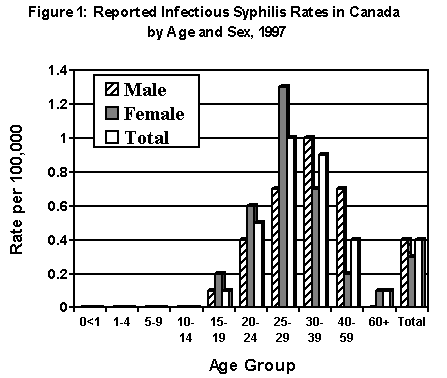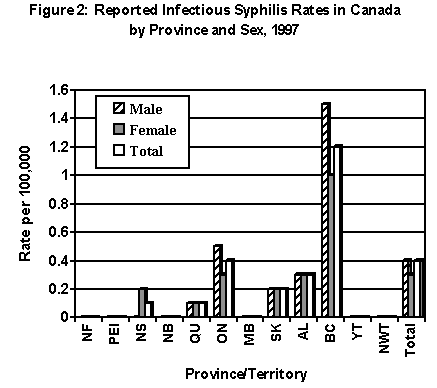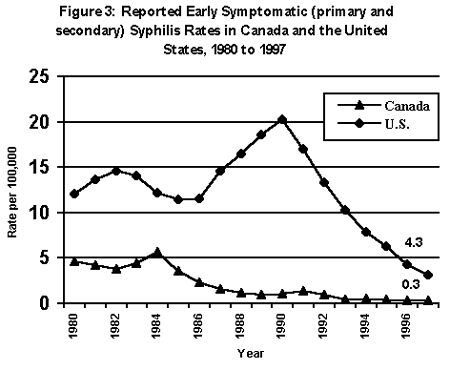Common menu bar links
Institutional links
Diseases & Conditions
Health & Safety
Research & Statistics
Agency Information
Search Box
E-mail this page
STI - Epi Update
April 1998
Syphilis in Canada: Elimination on the Horizon?
Syphilis in Canada: Elimination on the Horizon? Syphilis, a sexually transmitted infection, is classified into stages that reflect the degree of infectivity and progression of the disease: primary, secondary, early latent (asymptomatic syphilis <= 1 year), late latent (asymptomatic syphilis > 1 year), and tertiary. Untreated primary syphilis can progress to the tertiary stage when the bacteria invade the cardiovascular, nervous and musculoskeletal systems, eyes, and liver. Infection during pregnancy can lead to miscarriage, stillbirth, prematurity and congenital syphilis.
Before the availability of penicillin, syphilis was a significant cause of cardiovascular/neuropsychiatric disorders and blindness. However, transmission and disease progression can be effectively aborted with penicillin. With the arrival of HIV in the 1980's, syphilis took on new importance. It increases sexual transmission of HIV by six- to seven-fold1, and neurosyphilis in HIV-infected patients are particularly difficult to treat. Recent evidence has shown that early detection and treatment of STDs can have a major impact on the sexual transmission of HIV2-9. Because of this synergy10, syphilis control can have a significant impact on the HIV epidemic in Canada.
Gender and Age (Fig. 1)11
In 1997, the reported infectious syphilis (primary, secondary and early latent) gender ratio was 1.4M:1F. The peak incidence was noted in males in their 30's, in contrast to late 20's in females.

Geographic distribution (Fig. 2)11
In 1997, four provinces and two territories reported no infectious syphilis cases and all provinces/territories except British Columbia had reached the Year 2000 National Goal of <0.5 per 100,000 population. Infectious syphilis had been on the decline since 1985 in B.C., with rates dropping down to <= 0.5 per 100,000 population (<20 cases/year) from 1993 to 1996. In mid-1997, a syphilis outbreak associated with the sex trade in downtown Vancouver began12. The rate rose steeply to 1.2/100,000 population (48 cases) - the highest in the country. Despite extraordinary efforts by BCCDC staff, this outbreak is continuing, with preliminary rate in 1998 reaching 2.9/100,000 population13 (114 cases).
In 1997, all provinces/territories except British Columbia had reached the Year 2000 National Goal of no reported cases of congenital syphilis. B.C. reported the only 2 cases in all of Canada11,12.

Source: Bureau of HIV/AIDS, STD and TB, LCDC, Health Canada, May 1999.
Trends (Figure 3)11
The incidence of syphilis in Canada has been decreasing since the 1940's. This downward trend continued in 1997, with a total of 76 cases of primary and secondary syphilis being reported - a rate of 0.3 per 100,000 population11. This decline presents a window of opportunity to eliminate endemic transmission of syphilis in Canada. Despite a rate ten times (8,550 cases and a rate of 3.2 per 100,000 population) that of Canada's, United States is already embarking on such an endeavour14.

Source: Bureau of HIV/AIDS, STD and TB, LCDC, Health Canada, May 1999.
Can Syphilis Be Eliminated In Canada?
A number of factors favour the possibility of syphilis elimination. The slow growth rate (division time 33h) and the long incubation period (10-90 days) provide sufficient time to identify recent sexual contacts, allowing preventive therapy before development of clinical diseases15. Cheap and effective therapy for treatment and transmission interruption is achievable with penicillin. For those who are allergic to penicillin, treatment trials with azithromycin are underway and preliminary results are encouraging16,17. Clinically significant antimicrobial resistance has not surfaced and there are no animal reservoirs
Despite the decreasing incidence of syphilis in Canada, we have to sustain our control effort and be vigilant about the resurgence of syphilis, such as the current outbreak in British Columbia. Enhanced surveillance, screening, prevention, diagnosis and management programs must be developed to preventing such re-emergence in major cities, especially among the disenfranchised18. We must improve our capacity to respond to outbreaks quickly at the regional, provincial, territorial and national levels.
As the number of domestic cases in Canada dwindles, imported syphilis will become increasingly important. More prevention efforts should be targeted at travellers and immigrants as an estimated 12 million syphilis cases occur worldwide19.
Historically, only a handful of locally transmitted infectious diseases (eg. malaria, smallpox, polio) had been eliminated in Canada.. A sexually transmitted disease has never been eliminated. We are at a crossroad. Syphilis elimination initiative would not only reduce the individual and societal costs of syphilis, it would also strengthen the public health infrastructure that helps control diseases like HIV, hepatitis C and tuberculosis in the same marginalized populations. With sufficient resources, this can become a reality. The timing is ripe to consider such a historic initiative in Canada.
References
-
Nyange P, Martin H, Mandaliya K, et al. Cofactors for heterosexual transmission of HIV to prostitutes in Mombassa Kenya. Ninth International Conference on AIDS and STD in Africa, December 10-14, 1994, Kampala, Uganda.
-
Laga M, Alary M, Nzila N, et al. Condom promotion, sexually transmitted diseases treatment, and declining incidence of HIV-1 infection in female Zairian sex workers. Lancet 1994;344:246-248.
-
Moss GB, Overbaugh J, Welch M et al. Human immunodeficiency virus DNA in urethral secretions in men: association with gonococcal urethritis and CD4 depletion. J Infect Dis 1995;172:1469-1474.
-
Grosskurth H, Mosha F, Todd J, et al. Impact of improved treatment of sexually transmitted diseases on HIV infection in rural Tanzania: randomised controlled trial. Lancet 1995;346:530-536.
-
Boily MC, Anderson RM. Human immunodeficiency virus transmission and the role of other sexually transmitted diseases. Measures of association and study design. Sex Transm Dis 1996;23:312-332.
-
Hoffman I, Maida M, Royce R, et al. Effects of urethritis therapy on the concentration of HIV-1 in seminal plasma. Eleventh International Conference on AIDS, July 7-12, 1996, Vancouver, Canada.
-
Cohen M, Hoffman I, Royce R, et al. Reduction of concentration of HIV-1 in semen after treatment of urethritis: implications for prevention of sexual transmission of HIV-1. Lancet 1997;349:1868-1873.
-
Cohen MS. Sexually transmitted diseases enhance HIV transmission: no longer a hypothesis. Lancet 1998;351(suppl III):5-7.
-
Brisson M, Boily MC, Fournier A, Poulin C. The role of classical STD on the establishment of HIV in the strict heterosexual population of Montreal. Draft Proceedings of the 1999 STD Research Forum & National Goals Strategy Meeting, February 25-26,1999, Ottawa, Canada (in press).
-
Wasserheit JN. Epidemiologic synergy. Interrelationships between human immunodeficiency virus infection and other sexually transmitted diseases. Sex Transm Dis 1992;9:61-77.
-
Health Canada. Sexually Transmitted Diseases in Canada: 1996 Surveillance Report (with Preliminary 1997 Data). Division of STD Prevention & Control, Bureau of HIV/AIDS, STD & TB, LCDC, Health Canada.
-
Division of STD/AIDS Control, British Columbia Centre for Disease Control. STD Annual Report, 1997.
-
Patrick D. STD Update: British Columbia. Draft Proceedings of the 1999 STD Research Forum & National Goals Strategy Meeting, February 25-26,1999, Ottawa, Canada. (in press).
-
Division of STD Prevention. Sexually Transmitted Disease Surveillance, 1997. U.S. Department of Health and Human Services, Public Health Service. Atlanta: Centers for Disease Control and Prevention, September 1998.
-
Cumberland MC, Turner TB. The rate of multiplication of Treponema pallidum in normal and immune rabbits. Am J Syph Gon Vener Dis 1949;33:201-207.
-
Verdon MS, Hansfield HH, Johnson BB. Pilot study of azithromycin for treatment of primary and secondary syphilis. Clin. Infect Dis 1994;19:486-488.
-
Mashkilleyson AL, Gomberg MA, Mashkilleyson N, Kutin SA. Treatment of syphilis with azithromycin. Int J STD AIDS 1996;7(suppl 1):13-15.
-
Institute of Medicine. The hidden epidemic: confronting sexually transmitted diseases. Washington, DC: National Academy Press, 1997.
-
WHO, Global Programme on AIDS. Global prevalence and incidence of selected curable sexually transmitted diseases: overview and estimates. Geneva: WHO, 1996.
